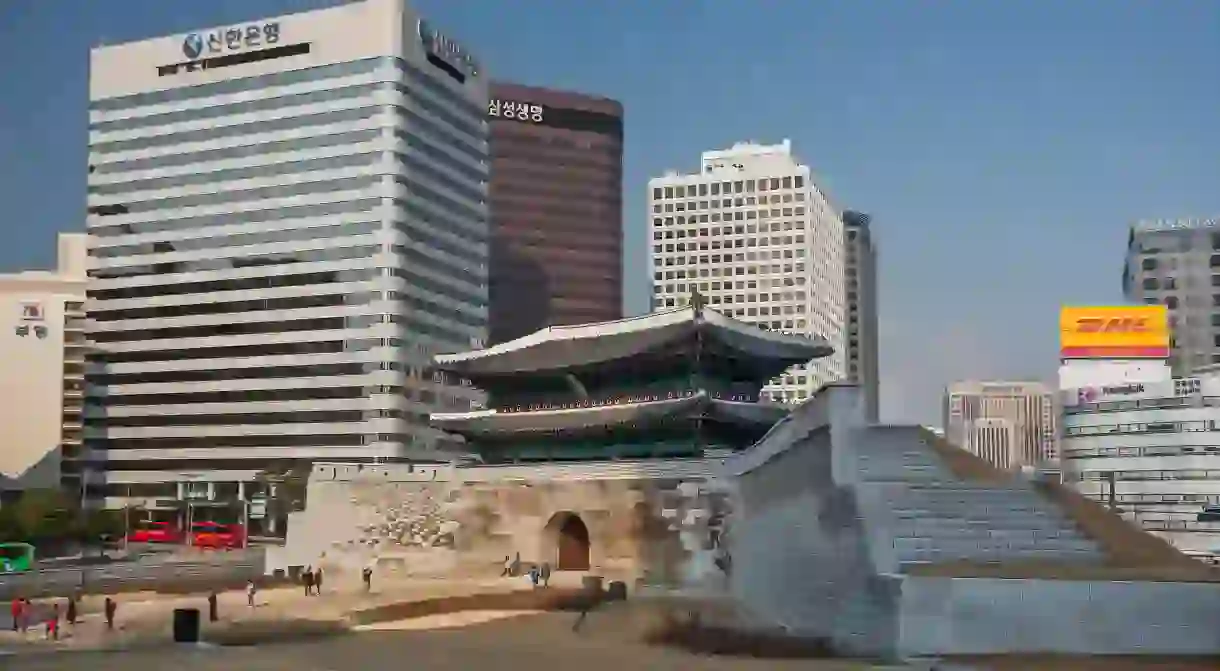The Tragic Story of Namdaemun, a Korean National Treasure

Korea’s designated National Treasures hold deep personal importance for its people. They are often symbols of hope, national character and religious belief. At the top of the list is Namdaemun, the celebrated structure that one night became a site of national mourning.
On 10 February 2008, in the South Korean capital city of Seoul, Chae Jong-gi crept into Namdaemun unnoticed, under the cover of darkness. It was a cold night, but anger drove the 69-year-old forward, up the stone steps and into the wooden pagoda with its elegantly painted eaves and tiles emblazoned with dragons. Chae then, by his own admission later, doused the wooden floor with paint thinner and burned South Korea’s National Treasure No. 1 to the ground.

What followed was an outpouring of national grief. After all, Namdaemun, officially named Sunghyemun, meant a great deal to the country. As a main gateway in the old city walls, it signified strength, endurance and stability. It was more than just an old relic of a bygone era. It was a symbol of survival through some of the darkest moments in Korean history, when so much of Korea’s heritage had been erased.
Incendiary timing
What is particularly ironic though about the timing of the arson was that, by the 21st century, Korea was in a peaceful ascendency, becoming a global leader in the electronics, automobile, shipbuilding and other heavy industries. Not since the Joseon era that created Namdaemun was there so much cause for national pride. Namdaemun had survived the bad luck exacted on Korea for decades, but it wasn’t able to survive the country’s rapidly growing good fortune.

Like a gripping K-drama, money and deceit were at the heart of it. Chae Jong-gi’s incendiary anger stemmed from a financial dispute with a property developer. Chae claimed that, after purchasing some land from him, the developer had only paid a fraction of the agreed-upon amount. Nobody in local government reacted to his calls for assistance, leaving him deeply embittered, to the ultimate chagrin of a nation.
Safeguarding the past
Completed in 1398 under the direction of the Joseon Dynasty’s founder, King Taejo, Namdaemun became a key gate in Seoul’s Fortress Wall. Joseon monarchs would go on to rule Korea for the next five centuries.
During the Joseon era, Namdaemun played a central role in the daily business of Seoul. It was the entry point for countless emissaries and traders who were welcomed in after weary journeys. It also kept the city’s inhabitants safe by keeping out unwanted forces and even tigers, which were yet to be hunted to extinction. Grain silos were kept nearby as it was also the main port of entry for farmers coming from the fertile rice-field-studded lands further south.
Much of the original gate of 1398 survived great turmoil over the preceding century, while precious little else in the country had. Japanese occupation was a particularly bad time for old Korean palaces and fortifications, especially in Seoul. The Korean War soon after destroyed much more.

One case in point was Gyeongbokgung Palace in central Seoul. As the main royal palace of the Joseon Dynasty, it comprised roughly 330 separate buildings at one point. By 1911, only a handful remained, the rest destroyed by the Empire of Japan. The main Joseon throne hall was blotted out by the Japanese General Government Building in a deliberate act of historical sabotage. Today no sign of the Japanese structure remains, and the main buildings of Gyeongbokgung have been faithfully recreated. But a recreation is never quite the same.
It was because of this historical significance and longevity that Namdaemun was designated a National Treasure by the Korean government in December 1962. It was included along with 115 additional tangible treasures, including temples, artefacts and carved edicts. Although not a list ordered in terms of their perceived value, the number one spot was reserved for Namdaemun.
By 2020 the list had swelled to 325 items. One of the most recently added being a portrait of King Taejo, an 1872 reproduction of an original commissioned during his reign, right around the same time that Namdaemun was being built.
Wooden regeneration
Like Gyeongbokgung, Namdaemun was faithfully rebuilt and its cream-coloured stone base is topped once more by a pretty double-tiered pagoda painted in red, blue and green. Heavy traffic slaloms around the outside, while the bulging stalls of Namdaemun Market overflow onto the nearby streets during peak hours. When lit up at night, the modern glass skyscrapers overlooking the old gate perfectly illustrate Korea’s classical glory alongside its modern one.



What saddens many about the new structure though, is that another prize relic was irrevocably lost. It only highlights the necessity of Korea’s National Treasures list, as a way of galvanising Korean heritage; of remembering, amid the embers of war, colonisation and embitterment, what it means to be Korean. While the act of arson on Namdaemun was a deeply unfortunate event, the reaction in Korea to the loss of a National Treasure indicated just how important these relics are and will always remain.













